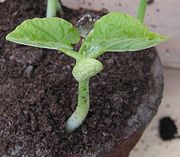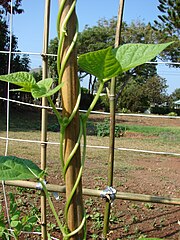Phaseolus vulgaris
| Phaseolus vulgaris | |
|---|---|
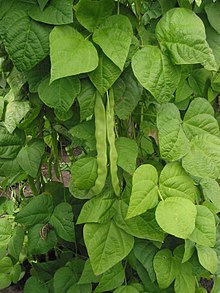
| |
A flat-podded variety of the common bean
| |
| Scientific classification | |
| Kingdom: | Plantae |
| Clade: | Tracheophytes |
| Clade: | Angiosperms |
| Clade: | Eudicots |
| Clade: | Rosids |
| Order: | Fabales |
| Family: | Fabaceae |
| Subfamily: | Faboideae |
| Genus: | Phaseolus |
| Species: | P. vulgaris
|
| Binomial name | |
| Phaseolus vulgaris | |
| Synonyms[2] | |
| |
Phaseolus vulgaris,thecommon bean,[3]is aherbaceousannual plantgrown worldwide for its edible dry seeds orgreen, unripe pods.Its leaf is also occasionally used as avegetableand thestrawasfodder.Itsbotanical classification,along with otherPhaseolusspecies, is as a member of thelegumefamilyFabaceae.Like most members of this family, common beans acquire thenitrogenthey require through an association withrhizobia,which arenitrogen-fi xingbacteria.
The common bean has a long history of cultivation. All wild members of the species have a climbing habit,[4][5]but manycultivarsare classified either asbush beansorclimbing beans,depending on their style of growth. The other major types of commercially grown beans are the runner bean (Phaseolus coccineus) and the broad bean (Vicia faba).
Beans are grown on every continent except Antarctica. Worldwide in 2022, 28 milliontonnesof dry common beans were produced, led by India with 23% of the total.[6]
Raw dry beans contain the toxic compoundphytohaemagglutinin,[7]which can be inactivated by cooking beans for ten minutes atboiling point(100 °C, 212 °F). The USFDAalso recommends an initial soak of at least 5 hours in water which should then be discarded.[7]
Description
[edit]Bush varieties form erect bushes 20–60 centimetres (8–20 inches) tall, while pole or running varieties formvines2–3 metres (7–10 feet) long. All varieties bear alternate, green or purpleleaves,which are divided into three oval, smooth-edged leaflets, each 6–15 cm (2–6 in) long and 3–11 cm (1–4 in) wide. The white, pink, or purpleflowersare about 1 cm long and have 10stamens.The flowers areself-pollinating,which facilitates the selection of stable cultivars. The flowers give way to pods 8–20 cm (3–8 in) long and 1–1.5 cm wide. These may be green, yellow, black, or purple, each containing 4–8 beans. Some varieties develop a string along the pod; these are generally cultivated for dry beans, as green stringy beans are not commercially desirable. The beans are smooth, plump, kidney-shaped, up to 1.5 cm long, range widely in color and are often mottled in two or more colors. The beans maintain their germination capacity up to 5 years.
Like most species fromPhaseolus,the genome ofP. vulgarishas 11 chromosomal pairs (2n = 22). Its genome is one of the smallest in the legume family at 625 Mbp per haploid genome.[8]
Raw or undercooked beans contain a toxic protein calledphytohaemagglutinin.[7]: 254
Taxonomy
[edit]The common bean, like all species ofPhaseolusis a member of thelegumefamilyFabaceae.
InSpecies Plantarumin 1753,Linnaeusclassified the beans known by him into genusPhaseolusand genusDolichos,naming 11 species ofPhaseolus,[9]including 6 cultivated species and 5 "wild" species.
The beans cultivated in Europe prior to theColumbian Exchangewere of Asian origin and are unrelated to New WorldPhaseolusspecies. The Eurasian species have been transferred to other genera includingVigna,ViciaandLablab,so members of thePhaseolusgenus are now all from the Americas.[10]
Etymology
[edit]Ancient Greeksused the word φάσηλος (phasēlos) to refer to the beans of Asian origins which were cultivated in Europe at the time.[11]TheRomansused both the Latinizedphaseolusand their ownfabato refer to different pre-Columbian species of beans,[12]presumably using the wordfaseolusfor smaller seeds like those belonging to the genusVignasuch as theblack-eyed peas[13]and the wordfabafor larger seeds, such as thefava beans.This latter word,faba,was related to theProto-Germanicbauno,from which theOld Englishwordbeanis derived and has the meaning of "bean, pea, legume".[14]WhenPhaseolus vulgarisarrived in Europe in the16th Century,this species was yet another seed in a pod, thus there were already words in the European languages describing it.
P. vulgariswas known asayacotlin theAzteclanguagenahuatl,búulinMayanandpurutuin theIncanlanguagequechua.In the Americas, indigenous names forP. vulgariswere not derived from Greek/Roman rootsphaselus/faseolus,as areCastilian Spanishfrijol,Portuguesefeijão,andCatalanfesol,but from the local languages. For example, it is calledporotoinChilean Spanish,from the Incanpurutu.
History
[edit]

1 –Mesoamericanarea
2 –Andeanarea
The wildP. vulgarisis native to theAmericas.It was originally believed that it had beendomesticatedseparately inMesoamericaand in the southernAndesregion ~8000 years ago, giving the domesticated bean twogene pools.[15][16]However, recent genetic analyses show that it was domesticated in Mexico first, before the split into the Mesoamerican and AndeanP. vulgarisgene pools.[17]
Beans,squashandmaize(corn) are the three Mesoamerican crops that constitute the"Three Sisters",central toindigenous American agriculture.[18]
The common bean arrived in Europe as part of theColumbian exchange.In 1528, the pope,Giulio de' Medici,received some white beans, which thrived. Five years later, he gave a bag of beans as a present to his niece,Catherine,on her wedding toPrince Henri of France,along with the county of theLauragais,whose county town isCastelnaudary,now synonymous with the white bean dish ofcassoulet.[19]
Cultivation
[edit]Good commercial yield in favorable environments under irrigation is 6 to 8 ton/ha fresh and 1.5 to 2 ton/ha dry seed.[20]
Cultivars and varieties
[edit]Archeologists found large-seeded varieties of the domesticated bean in the highlands of Peru, dating to 2300 BC, and spreading to the coastal regions by around 500 BC.[21]Small-seeded varieties were found in sites in Mexico, dating to 300 BC, which then spread north and east of theMississippi Riverby 1000 AD.[21]
Many well-known beancultivarsand varieties belong to this species, and the list below is in no way exhaustive. Both bush and running (pole) cultivars/varieties exist. The colors and shapes of pods and seeds vary over a wide range. See:https:// legumedata.org/taxonomy/taxon/2537710https:// legumedata.org/taxonomy/taxon/2537710
| Name | Image | Description |
|---|---|---|
| Anasazi | 
|
Anasazi beans are a dappled red and white bean first cultivated byAncestral Puebloanpeople around 130 CE in what is now theFour Cornersregion of the United States. Anasazi Bean is often confused with Jacob's Cattle variety, but Anasazi has splashes of color, whereas Jacob's Cattle has splashes and small spots. Anasazi beans were adopted by commercial growers beginning in the 1980s and marketed under the name "Anasazi"; traditionally they were known by the Spanish namesfrijol conejo(rabbit bean),vaquita(little cow), orpájaro carpintero(woodpecker).[22][23] |
| Appaloosa | 
|
Front portion of the bean is ivory colored; the other end is speckled with reddish-purple and mocha. The bean is named after theAppaloosaponies of theNez Perce tribe.The seed was cultivated near thePalouse Riverin EasternWashingtonand NorthernIdaho. |
| Black turtle | 
|
The black turtle bean has small, shiny black seeds. It is especially popular in Latin American cuisine. |
| Bolita bean | 
|
Bolita beans are a traditional variety utilized inNew Mexican cuisinebyNew Mexican Hispanosfrom northernNew Mexicoand southernColorado.They can range from whitish-tan to beige, and even pinkish-purple in color. |
| Calypso | 
|
Calypso beans, also called Panda beans or Yin Yang beans, are half black and half white, with one or two black dots in the white area. When young, the pods can be harvested as a green bean. But when full-grown, they are used as a bean for drying. |
| Cranberry | Thecranberry beansoriginated inColombiaas thecargamantobean. Borlotti or Roman beans are a variety of cranberry bean bred in Italy to have a thicker skin. They are much used in Mediterranean cuisine. A widespread cultivar of European borlotti is 'Borlotto Lingua di Fuoco' (Tongue of Fire). | |
| Dragon tongue | 
|
Dragon tongue bean is a type ofcranberry bean.It is a flavorful, juicy bean whose seeds are encased in a buffed, colorful pod with mottled burgundy patterns throughout the shell's surface. The shelled beans are pale pistachio green in color, their size, petite, and their shape, ovate and slightly curved.[24] |
| Flageolet | 
|
Flageolet beans are picked before full maturity and dried in the shade to retain a green color and a distinct taste. The seeds are small, light green, and kidney-shaped. The texture is firm yet creamy if shelled and cooked when fresh but semi-dry. They are often eaten in France, where they traditionally accompany lamb. |
| Kidney | 
|
Kidney beans, also known as red beans, are named for their visual resemblance in shape and color tokidneys.They are sometimes used inchili con carneand are an integral part of the cuisine in northern regions of India. They are also used in New Orleans and much of southern Louisiana for the Monday Creole dish ofred beans and riceas well as the Caribbeanhabichuelas guisadasand Central Americangallo pinto. |
| Jacob's Cattle | 
|
Similar to Anasazi in appearance, with the exception of having also dots. Legend says thePassamaquoddyindigenous people ofMainegave these beans as a gift to Joseph Clark, the first Caucasian child born in Lubec, Maine in the 1600s. Also known as Trout.[25] |
| Mocha with Cherry | 
|
"Mocha with Cherry" is a polebean. This variety is said to come from the Rodope area in Bulgaria, and to be related to "Papa de Rola" and "Dove's Breast". |
| North Holland Brown | 
|
This bean is an old Dutch Heirloom bush variety primarily used for dried beans. |
| Pea,Painted Pony | A type ofP. vulgariscalled pea bean has been recorded in Britain since the 16th century.[26]In the US, the name "pea bean" is also used to describe small white beans, and the same name is used forVigna unguiculatasubsp.sesquipedalis,also called yard-long bean and cowpea.[27]The seeds of the British pea bean are bicolored red-brown and white (not to be confused with Jacob's Cattle, which is more dark red than reddish-brown). The plants are typical climbing beans. The beans are either eaten in the pod-like French beans or may be harvested when mature and eaten as other dried beans.[28] | |
| Peruano | 
|
Also known as mayocoba, canary, canario, Peruvian, Mexican yellow bean. A light green to jaundice yellow kidney-shaped bean that is preferred in certain regions of Mexico (such as Jalisco[29]) for makingfrijoles refritos,and in Peru for makingtacu tacu,a pan-fried cake of leftover beans and rice.[30]Often described as having a "buttery" and "creamy" texture. |
| Pink | 
|
Pink beans are small, pale pink, oval-shaped beans also known by the Spanish namehabichuelas rosadas.[31]TheSanta Mariapinquito(Spanglish= pink and small), is commercially grown on the mesas above Santa Maria, California, and is a necessary ingredient inSanta Maria-style barbecue. |
| Pinto | 
|
Pinto beans are named for their mottled skin (Spanish:pinto= painted or mottled). They are the most common bean in the United States[32]and northwestern Mexico,[33]and are most often eaten whole in broth or mashed andrefried.Either whole or mashed, they are a common filling forburritos.The young pods may also be harvested and cooked as green pinto beans. |
| Polish Eagle Beans | 
|
Also called by the Independence bean by the Polish people because the brown pattern on the inner side of the bean resembles and Eagle - the Polish emblem. This bean variety was cultivated in XIX century as an act of patriotism by Polish people.[34] |
| Rattlesnake | 
|
A medium-sized, oblong bean with light brown seeds striped with brown markings. Named for the snake-like manner in which their pods coil around the vine.[35] |
| Sulphur | aka China Yellow Bean: A thin-skinned, nearly roundMaineheirloom bean that has a tawny yellow color but cooks white and has a distinctly unique flavor.[36]This is a choice variety for use in the traditional Bean Hole style.[37] | |
| Tiger's Eye | 
|
A bush variety, thought to have originated in Chile or Argentina.[38] |
| White | 
|
Navy beansor haricot beans are particularly popular in the United Kingdom and the United States. Other white beans include cannellini, a popular variety in central andsouthern Italythat is related to thekidney bean.White beans are the most abundant plant-based source ofphosphatidylserineknown.[39] |
| Yellow (Enola type) | 
|
'Sinaloa Azufrado,' 'Mayocoba,' and 'Peruano' (also called canary) are yellow beans. Peruano beans (see above) are small, oval, yellow beans about 1/2 in (1 cm) long with a thin skin. They have a creamy texture when cooked. Despite the name ('Peruvian beans' in Spanish), they are native to Mexico. Yellow beans are uncommon in the United States due to a controversial patent issued in 1999 to John Proctor, who selected and named a strain of yellow bean from seeds he brought back from Mexico. U.S. Patent No. 5,894,079 (theEnola or yellow bean patent) granted POD-NERS, LLC., exclusive right to import and sell yellow beans in the United States from 1999 through 2008 when the patent was rejected after reexamination.[40][41] |
| Yellow Eye | 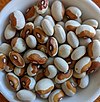
|
aka Maine Yellow Eye, this is the most popular baking bean inMaine,which comes in several strains, including the 'Steuben,' one of the oldest heirloom beans. It has a wide appeal for its clean, mild taste and is considered the baked bean of choice for church and grange suppers.[36] |
Production
[edit]| Country | Millions oftonnes |
|---|---|
| 6.6 | |
| 2.8 | |
| 2.7 | |
| 1.3 | |
| 1.2 | |
| 1.0 | |
| World | 28.3 |
| Source:FAOSTATof theUnited Nations[6] | |
In 2022, world production of dry common beans was 28 million tonnes, led by India with 23% of the total (table).BrazilandMyanmarwere secondary producers.
Toxicity
[edit]The toxic compoundphytohaemagglutinin,alectin,is present in many common bean varieties but is especially concentrated in red kidney beans. White kidney beans contain about a third as many toxins as the red variety; broad beans (Vicia faba) contain 5 to 10% as much as red kidney beans.[7]
Phytohaemagglutinin can be inactivated by cooking beans for ten minutes atboiling point(100 °C, 212 °F). Insufficient cooking, such as in aslow cookerat 80 °C/ 176 °F, is insufficient to deactivate all toxins. To safely cook the beans, the U.SFood and Drug Administrationrecommends boiling for 30 minutes to ensure they reach a sufficient temperature for long enough to destroy the toxin completely.[42]For dry beans, the FDA also recommends an initial soak of at least 5 hours in water which should then be discarded.[7]Outbreaks of poisoning have been associated with cooking kidney beans inslow cookers.[7]
The primarysymptomsof phytohaemagglutinin poisoning are nausea, vomiting, and diarrhea. Onset is from one to three hours after consumption of improperly prepared beans, and symptoms typically resolve within a few hours.[7]Consumption of as few as four or five raw, soaked kidney beans can cause symptoms.[7]Canned red kidney beans are safe to use immediately, as they have already been cooked.[43][44][45]
Beans are high inpurines,which are metabolized touric acid.Uric acid is not a toxin but may promote the development or exacerbation ofgout.However, more recent research has questioned this association, finding that moderate intake of purine-rich foods is not associated with an increased risk of gout.[46]
Uses
[edit]Nutrition
[edit]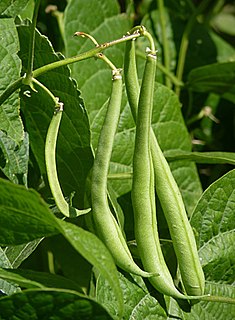 | |
| Nutritional value per 100 g (3.5 oz) | |
|---|---|
| Energy | 152 kJ (36 kcal) |
6.97 g | |
| Sugars | 3.26 g |
| Dietary fiber | 2.7 g |
0.22 g | |
1.3 g | |
| Vitamins | Quantity %DV† |
| Vitamin A equiv. | 4% 35 μg4% 379 μg640 μg |
| Thiamine (B1) | 7% 0.082 mg |
| Riboflavin (B2) | 8% 0.104 mg |
| Niacin (B3) | 5% 0.734 mg |
| Pantothenic acid (B5) | 5% 0.225 mg |
| Vitamin B6 | 8% 0.141 mg |
| Folate (B9) | 8% 33 μg |
| Vitamin C | 14% 12.2 mg |
| Vitamin E | 3% 0.41 mg |
| Vitamin K | 36% 43 μg |
| Minerals | Quantity %DV† |
| Calcium | 3% 37 mg |
| Copper | 8% 0.069 mg |
| Iron | 6% 1.03 mg |
| Magnesium | 6% 25 mg |
| Manganese | 9% 0.216 mg |
| Phosphorus | 3% 38 mg |
| Potassium | 7% 211 mg |
| Selenium | 1% 0.6 μg |
| Sodium | 0% 6 mg |
| Zinc | 2% 0.24 mg |
| Other constituents | Quantity |
| Water | 90.3 g |
| †Percentages estimated usingUS recommendationsfor adults,[47]except for potassium, which is estimated based on expert recommendation fromthe National Academies.[48] | |
 | |
| Nutritional value per 100 g (3.5 oz) | |
|---|---|
| Energy | 581 kJ (139 kcal) |
25.1 g | |
| Sugars | 0.34 g |
| Dietary fiber | 6.3 g |
0.35 g | |
9.73 g | |
| Vitamins | Quantity %DV† |
| Thiamine (B1) | 10% 0.118 mg |
| Riboflavin (B2) | 4% 0.046 mg |
| Niacin (B3) | 1% 0.14 mg |
| Pantothenic acid (B5) | 5% 0.229 mg |
| Vitamin B6 | 5% 0.093 mg |
| Folate (B9) | 20% 81 μg |
| Vitamin C | 0% 0 mg |
| Vitamin E | 6% 0.94 mg |
| Vitamin K | 3% 3.5 μg |
| Minerals | Quantity %DV† |
| Calcium | 7% 90 mg |
| Copper | 32% 0.287 mg |
| Iron | 21% 3.7 mg |
| Magnesium | 15% 63 mg |
| Manganese | 28% 0.636 mg |
| Phosphorus | 9% 113 mg |
| Potassium | 19% 561 mg |
| Selenium | 2% 1.3 μg |
| Sodium | 0% 6 mg |
| Zinc | 13% 1.38 mg |
| Other constituents | Quantity |
| Water | 63.1 g |
| †Percentages estimated usingUS recommendationsfor adults,[47]except for potassium, which is estimated based on expert recommendation fromthe National Academies.[48] | |
Raw green beans are 90% water, 7%carbohydrates,1%protein,and contain negligiblefat(table). In a reference amount of 100 grams (3.5 oz), raw green beans supply 36calories,and are a rich source (20% or more of theDaily Value,DV) ofvitamin K(41% DV) and a moderate source (10-19% DV) ofvitamin C,vitamin B6,andmanganese(table).
Dry white common beans after boiling are 63% water, 25% carbohydrates, 10% protein, and contain little fat (table). In a reference amount of 100 grams (3.5 oz), boiled white common beans supply 139 calories and are a rich source offolateand manganese, with moderate amounts ofthiamineand several dietaryminerals(table).
Dry beans
[edit]Dry beans will keep indefinitely if stored in a cool, dry place, but as time passes, theirnutritivevalue andflavordegrade, and cooking times lengthen. Dried beans are almost always cooked byboiling,often after being soaked in water for several hours. While the soaking is not strictly necessary, it shortens cooking time and results in more evenly textured beans. In addition, soaking beans removes 5 to 10% of the gas-producing sugars that can causeflatulencefor some people.[49]The methods include simple overnight soaking and the power soak method, in which beans are boiled for three minutes and then set aside for 2–4 hours. Before cooking, the soaking water is drained off and discarded. Dry common beans take longer to cook than mostpulses:cooking times vary from one to four hours but are substantially reduced withpressure cooking.
In Mexico, Central America, and South America, the traditional spice used with beans isepazote,which is also said to aid digestion. In East Asia, a type of seaweed,kombu,is added to beans as they cook for the same purpose. Salt, sugar, and acidic foods such as tomatoes may harden uncooked beans, resulting in seasoned beans at the expense of slightly longer cooking times.[citation needed]
Dry beans may also be bought cooked andcannedasrefried beans,or whole withwater,salt,and sometimessugar.
Green beans and wax beans
[edit]The three commonly known types of green beans are string or snap beans, which may be round or have a flat pod; stringless or French beans, which lack a tough, fibrous string running along the length of the pod; and runner beans, which belong to a separate species,Phaseolus coccineus.Green beans may have a purple rather than green pod, which changes to green when cooked.[50]Wax beans areP. vulgarisbeans that have a yellow[4]or white pod. Wax bean cultivars are commonly grown;[4]the plants are often of the bush or dwarf form.[4]
As the name implies, snap beans break easily when the pod is bent, giving off a distinct audible snap sound. The pods of snap beans (green, yellow and purple) are harvested when they are rapidly growing, fleshy, tender (not tough and stringy), and bright in color, and the seeds are small and underdeveloped (8 to 10 days after flowering).
Green beans and wax beans are oftensteamed,boiled,stir-fried,orbakedincasseroles.
Shelling beans
[edit]Shell, shelled, or shelling beans are beans removed from their pods before being cooked or dried. Common beans can be used as shell beans, but the term also refers to other species of beans whose pods are not typically eaten, such aslima beans,soybeans,peas,andfava beans.Fresh shell beans are nutritionally similar to dry beans but are prepared more like vegetables, often steamed, fried, or made into soups.[citation needed]
Popping beans
[edit]Thenuñais an Andean subspecies,P. v.subsp.nunas(formerlyP. vulgarisNuñas group), with round, multicolored seeds that resemble pigeon eggs. When cooked on high heat, the bean explodes, exposing the inner part in the manner ofpopcornand otherpuffed grains.
Other uses
[edit]Bean leaves have been used to trapbedbugsin houses.[51]Microscopic hairs (trichomes) on the bean leaves entrap the insects.[51]
From ancient times, beans were used as devices in various methods ofdivination.Fortune-telling using beans is calledfavomancy.
P. vulgarishas been found to bio-accumulatezinc,manganese,andironand have some tolerance to their respective toxicities, suggesting suitability for natural bio-remediation of heavy-metal-contaminated soils.[52][non-primary source needed]
Gallery
[edit]-
Beans with smoked pork, a traditionalRomaniandish
See also
[edit]- Adzuki bean
- Chickpea
- Dal
- Lentil
- List of dried foods
- List of diseases of the common bean
- Mung bean
- Organic beans
- Pressure cooking
- Vicia faba,or broad bean
References
[edit]- ^Delgado-Salinas, A.; Alejandre-Iturbide, G.; Azurdia, C.; Cerén-López, J. & Contreras, A. (2020)."Phaseolus vulgaris".IUCN Red List of Threatened Species.2020:e.T71777161A173264641.doi:10.2305/IUCN.UK.2020-2.RLTS.T71777161A173264641.en.Retrieved11 November2022.
- ^"The Plant List: A Working List of All Plant Species".
- ^Gentry, Howard Scott (1969). "Origin of the Common Bean,Phaseolus vulgaris".Economic Botany.23(1). New York: New York Botanical Garden Press: 55–69.doi:10.1007/BF02862972.JSTOR4253014.S2CID29555157.,
- ^abcdPhillips, R.; Rix, M. (1993).Vegetables.New York: Random House.ISBN978-0-679-75024-6.[page needed]
- ^Raja, Vicente; Silva, Paula L.; Holghoomi, Roghaieh; Calvo, Paco (2020-11-10)."The dynamics of plant nutation".Scientific Reports.10(1): 19465.Bibcode:2020NatSR..1019465R.doi:10.1038/s41598-020-76588-z.ISSN2045-2322.PMC7655864.PMID33173160.
- ^abc"Dry bean production in 2022, Crops/Regions/World list/Production Quantity/Year (pick lists)".UN Food and Agriculture Organization, Corporate Statistical Database (FAOSTAT). 2024.Retrieved20 February2024.
- ^abcdefgh"Bad Bug Book: Handbook of Foodborne Pathogenic Microorganisms and Natural Toxins: Phytohaemagglutinin"(PDF).United StatesFood and Drug Administration.Archived(PDF)from the original on 2013-04-18.Retrieved2020-04-17.
- ^Gepts, P. (2001).Encyclopedia of Genetics.Elsevier. pp. 1444–1445.doi:10.1006/rwgn.2001.1749.ISBN978-0-12-227080-2.
- ^Linnaei, Caroli (1753).Species plantarum: exhibentes plantas rite cognitas...(thanks tobiodiversitylibrary.org)(in Latin). pp. 723–725.Retrieved2023-11-18.
- ^Chauvet, M. (1982)."Le point sur la nomenclature des haricots, à l'occasion de la parution de la monographie de Maréchal, Mascherpa et Stainie".Journal d'agriculture traditionnelle et de botanique appliquée(in French).29(1): 31–39.
- ^Heinrich, F. B. J.; Wilkins, D. A. (2014-12-14)."Beans, boats and archaeobotany. a new translation of phasolus or why the romans ate neither kidney beans nor cowpeas".Palaeohistoria.55/56. University of Groningen Press: 149–176.ISSN2773-1723.PDF
- ^Sturtevant, E. L (1887)."History of Garden Vegetables".The American Naturalist.21(4): 321–333.doi:10.1086/274456.Retrieved2 December2023.
p.328: Albertus Magnus, who lived in the thirteenth century, used the word faselus as denoting a specific plant, as "faba et faseolus et pisa et alia genera leguminis," "cicer, faba, faseolus."
- ^Sturtevant, E. L (1887)."History of Garden Vegetables".The American Naturalist.21(4): 321–333.doi:10.1086/274456.Retrieved2 December2023.
p.328: He [Albertus Magnus] also says, "Et sunt faseoli multorum colorum, sed quodlibet granorum habet maculam nigramin loco cotyledonis."
- ^Harper, D. (n.d.)."Etymology of bean".Online Etymology Dictionary.Retrieved2 December2023.
- ^Paul Gepts (December 1998)."Origin and evolution of common bean: past events and recent trends".HortScience.33(7): 1124–1130.doi:10.21273/HORTSCI.33.7.1124.
- ^Nadeem, Muhammad Azhar; Habyarimana, Ephrem; Çiftçi, Vahdettin; Nawaz, Muhammad Amjad; Karaköy, Tolga; Comertpay, Gonul; Shahid, Muhammad Qasim; Hatipoğlu, Rüştü; Yeken, Mehmet Zahit; Ali, Fawad; Ercişli, Sezai; Chung, Gyuhwa; Baloch, Faheem Shehzad (2018-10-11)."Characterization of genetic diversity in Turkish common bean gene pool using phenotypic and whole-genome DArTseq-generated silicoDArT marker information".PLOS ONE.13(10): –0205363.Bibcode:2018PLoSO..1305363N.doi:10.1371/journal.pone.0205363.ISSN1932-6203.PMC6181364.PMID30308006.
- ^Rendón-Anaya, M.; et al. (2017)."Genomic history of the origin and domestication of common bean unveils its closest sister species".Genome Biology.18.Article number: 60.doi:10.1186/s13059-017-1190-6.PMC5370463.PMID28356141.
- ^Hill, Christina Gish (2020-11-20)."Returning the 'three sisters' – corn, beans, and squash – to Native American farms nourishes people, land and cultures".The Conversation.Retrieved2021-01-08.
- ^Taylor, Colin Duncan (2021).Menu from the Midi: A Gastronomic Journey through the South of France.Matador.ISBN978-1-80046-496-4.
- ^Food and Agriculture Organization of the United Nations (2023)."Bean".fao.org.Retrieved2023-11-18.
- ^abPearman, Georgina (2005). Prance, Ghillean; Nesbitt, Mark (eds.).The Cultural History of Plants.Routledge. pp. 143–144.ISBN0-415-92746-3.
- ^Wittenberg, Margaret M. (2013).The Essential Good Food Guide(3 ed.). Berkeley: Ten Speed Press. p. 145.ISBN978-1-60774-434-4.RetrievedJune 10,2019.
- ^Wood, Rebecca (May 2, 1993)."Oh, Beans! The Anasazi is 7,000 years old and still growing".Albuquerque Journal.RetrievedJune 11,2019– via Newspapers.
- ^"Dragon Tongue Shelling Beans".Specialty Produce.Retrieved17 November2023.
- ^"Jacob's Cattle Bean".Slow Food USA.org.Retrieved17 April2023.
Slow Food USA tends the Ark of Taste catalog, a repository of critically important but increasinglycritically important but increasingly endangered food sources.
- ^"The Herball or Generall Historie of Plantes (1597)".mpg.de.p. 1040.
The party coloured kidney bean of EgyptPhaseolus aegypticus
- ^"Vigna unguiculatasubsp.sesquipedalis".Germplasm Resources Information Network.Agricultural Research Service,United States Department of Agriculture.RetrievedSeptember 22,2013.
- ^– The National Vegetable Society – the Pea beanArchivedJanuary 25, 2007, at theWayback Machine
- ^Sando, Steve; Barrington, Vanessa (2008).Heirloom Beans(1 ed.). San Francisco, CA: Chronicle Books. p. 17.ISBN978-0-8118-6069-7.
- ^Yonan, Joe (2020).Cool Beans: The Ultimate Guide to Cooking with the World's Most Versatile Plant-Based Protein(3 ed.). Berkeley: Ten Speed Press. p. 217.ISBN978-0-399-58149-6.
- ^"Pink Bean – Definition and Cooking Information".RecipeTips.Retrieved2012-01-14.
- ^"Maize 2003 CGC Meeting".Ars-grin.gov. Archived fromthe originalon 2012-09-15.Retrieved2012-01-14.
- ^"Situación actual y perspectiva de la producción de Frijol en México 1990-2000"[Current situation and perspective of bean production in Mexico 1990-2000](PDF).Federal government of Mexico(in Mexican Spanish). May 28, 2001. Archived fromthe original(PDF)on April 10, 2005.
- ^Slurrp Editorial (Jan 7, 2023)."Uncovering The History Behind Poland's Iconic Eagle Bean: A Symbol Of Independence".Retrieved16 November2023.
- ^Ron Herbst; Sharon Tyler Herbst (2015).The Deluxe Food Lover's Companion, 2nd edition.Barron's Educational Series. pp. 1439–.ISBN978-1-4380-7621-8.
- ^ab"A Taste of Maine".The University of Maine Folklife Center.Retrieved2021-02-22.
- ^"A Maine Tradition: Bean-Hole Beans".The University of Maine Folklife Center.Retrieved2021-02-22.
- ^Seed Savers Exchange."Tiger's Eye Bean".seedsavers.org/.Retrieved16 April2023.
- ^Souci SW, Fachmann E, Kraut H (2008). Food Composition and Nutrition Tables. Medpharm Scientific Publishers Stuttgart.
- ^"The Enola Bean Patent Controversy: Biopiracy, Novelty And Fish-And-Chips".Law.duke.edu. Archived fromthe originalon 2012-04-02.Retrieved2012-01-14.
- ^"Appeal 2007-3938"(PDF).Retrieved2012-01-14.
- ^"Bad Bug Book (2012)"(PDF).Foodborne Pathogenic Microorganisms and Natural Toxins Handbook: Phytohaemagglutinin.Food and Drug Administration. 2012.Retrieved26 December2013.
Consumers should boil the beans for at least 30 minutes to ensure that the product reaches sufficient temperature
- ^"Be Careful With Red Kidney Beans in The Slow Cooker".Mother Earth News.31 January 2013.
- ^"Cooking safely with slow cookers and crock pots".foodsmart.govt.nz.Archived fromthe originalon 2016-01-02.Retrieved2014-01-06.
- ^"Raw Kidney Beans".Home Food Preservation (Penn State Extension).
- ^Choi HK, Atkinson K, Karlson EW, Willett W, Curhan G (March 2004)."Purine-rich foods, dairy and protein intake, and the risk of gout in men".N. Engl. J. Med.350(11): 1093–103.doi:10.1056/NEJMoa035700.PMID15014182.S2CID6478950.
- ^abUnited States Food and Drug Administration(2024)."Daily Value on the Nutrition and Supplement Facts Labels".FDA.Archivedfrom the original on 2024-03-27.Retrieved2024-03-28.
- ^abNational Academies of Sciences, Engineering, and Medicine; Health and Medicine Division; Food and Nutrition Board; Committee to Review the Dietary Reference Intakes for Sodium and Potassium (2019). Oria, Maria; Harrison, Meghan; Stallings, Virginia A. (eds.).Dietary Reference Intakes for Sodium and Potassium.The National Academies Collection: Reports funded by National Institutes of Health. Washington, DC: National Academies Press (US).ISBN978-0-309-48834-1.PMID30844154.Archivedfrom the original on 2024-05-09.Retrieved2024-06-21.
- ^Rombauer, Irma S.The Joy of Cooking.Scribner,ISBN0-684-81870-1,p. 271.
- ^Press, L. (2002).The Bean Book: Over Seventy Incredible Recipes.Guilford, Conn.: Globe Pequot Press.ISBN978-1-58574-473-2.[page needed]
- ^abSzyndler, M.W.; Haynes, K.F.; Potter, M.F.; Corn, R.M.; Loudon, C. (2013)."Entrapment of bed bugs by leaf trichomes inspires microfabrication of biomimetic surfaces".Journal of the Royal Society Interface.10(83): 20130174.doi:10.1098/rsif.2013.0174.ISSN1742-5662.PMC3645427.PMID23576783.
- ^Mazumdar, K.; Das, S. (2015). "Phytoremediation of Pd, Zn, Fe, and Mg with 25 wetland plant species from a paper mill contaminated site in North East India".Environ. Sci. Pollut. Res. Int.22(1): 197–209.doi:10.1007/s11356-014-3377-7.PMID25103945.S2CID3482592.
External links
[edit] Data related toPhaseolus vulgarisat Wikispecies
Data related toPhaseolus vulgarisat Wikispecies Food portal
Food portal Agriculture portal
Agriculture portal Botany portal
Botany portal



